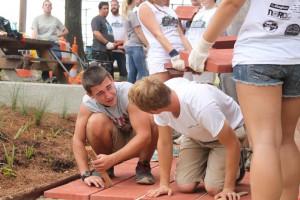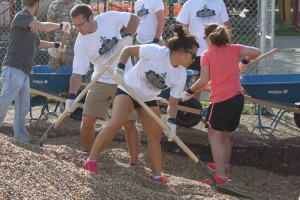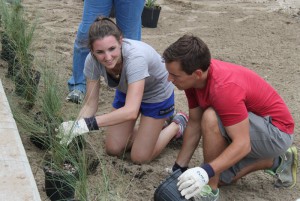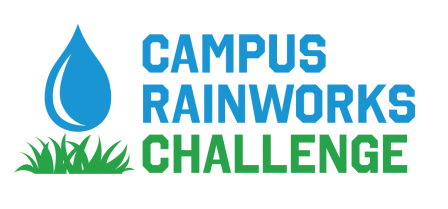
Volunteers participate in this year’s WEFTEC community service project, “Recharge, Restore, Revitalize Hollygrove: Conrad Park Green Infrastructure Enhancements.”
…
Volunteers from across the country met in New Orleans September 27 to participate in the 7th Annual Water Environment Federation (WEF) Community Service Project, “Recharge, Restore, Revitalize Hollygrove: Conrad Park Green Infrastructure Enhancements.” The service project occurred at the start of WEFTEC® 2014, and more than 100 volunteers spent their Saturday constructing a rain garden, permeable pavers, and bioswales at Conrad Park, a recreation hub in the Hollygrove neighborhood. Conrad Park suffers from flooding during rain events, preventing neighborhood children from using the playground, basketball court, and community center.
The city of New Orleans has the third highest average rainfall in the U.S. at 163 cm (64 in) per year. Hollygrove is also a naturally low-lying neighborhood, making it more susceptible to flooding. It is expected that the addition of green infrastructure will greatly reduce the volume of stormwater in and near the park both during and after a rain event. The park’s rain garden and bioswales also should reduce the velocity of runoff before it reaches the neighborhood’s traditional pipe infrastructure.
The design was created by Dana Brown & Associates and supervised by the landscape architecture firm as well as staff from the Sewerage and Water Board of New Orleans.Volunteers started the project by filling the bioswale trenches adjacent to the park and neighboring roads with aggregate. A large area within the park was also filled with aggregate, and this became the rain garden. These areas were excavated and a retaining wall was built previously, so the volunteers could lay the media and plants that Saturday. Next, a sandy loam soil was spread on top of the aggregate in all three areas, and in the rain garden, volunteers planted more than 800 plants. The increased permeability of these areas will allow stormwater to easily infiltrate, instead of pooling on top of the compacted soil that was previously in these locations. Plants in the rain garden also will reduce the volume of stormwater through transpiration. A permeable pavement path also was added to allow easier access between the park’s recreation facilities.

Volunteers lay pavers for a permeable walkway that connects the community center with the basketball court and playground.
The total cost of this project would have been about $40,000, but through donations and volunteer services, the cost was reduced by half. Four volunteers from the Water Environment Federation’s Young Professionals Committee successfully led the service project: Michael Quamme, Haley Falconer, Timothy Moran, and Michelle Hatcher. The project at Conrad Park was also made possible by the cooperation of many companies and organizations, including the Louisiana Urban Stormwater Coalition; the Sewerage and Water Board of New Orleans; Engineers Without Borders; Dana Brown & Associates, Inc.; the New Orleans Recreation Department Commission; New Orleans City Council Member Susan Guidry; Harrah’s Hotel and Casino; and the Water Environment Federation.

Michael Quamme, lead for the WEFTEC Community Service Project in New Orleans, discusses project successes for volunteers and local media.







